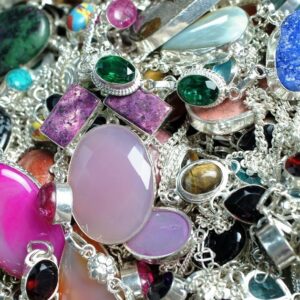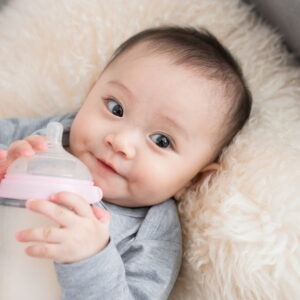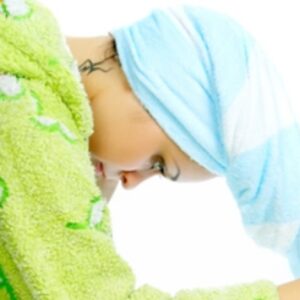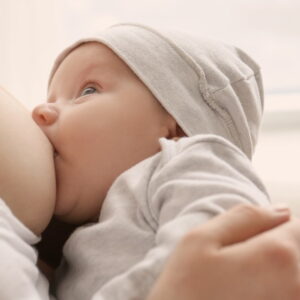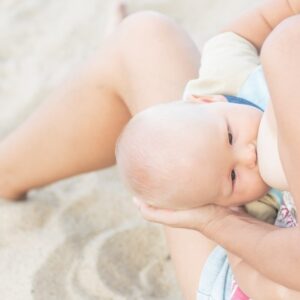Nipple thrush or breast fungus is painful, and you want to prevent it or treat it quickly. Here we go through effective treatments and ways to prevent nipple thrush.
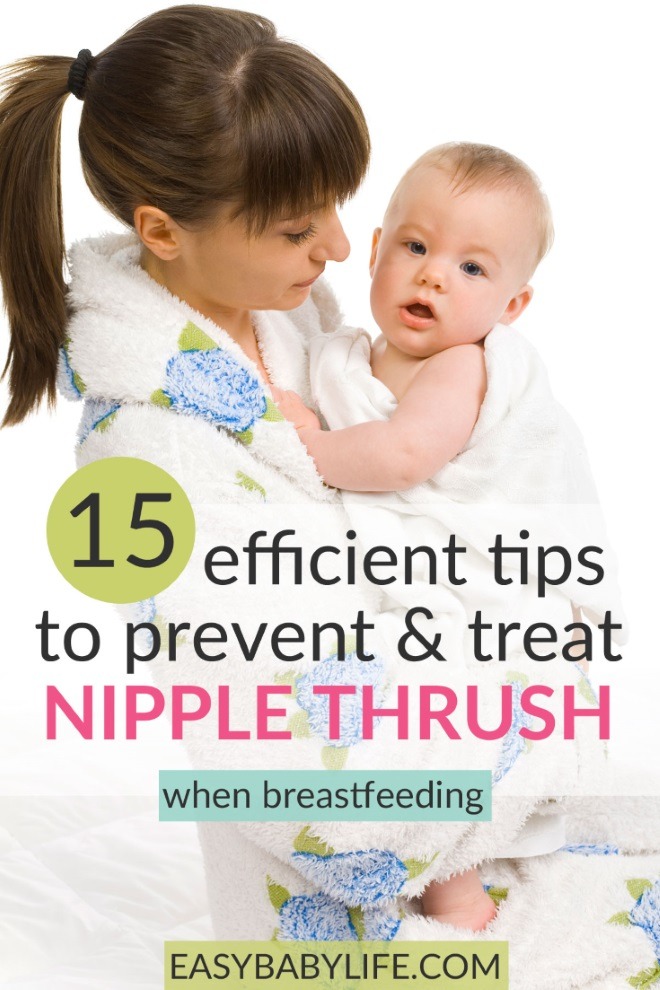
Nipple thrush – another less attractive part of becoming a mother that no one told us!
Nipple thrush is a fungus that grows around your nipple or even in your breast. It usually spreads to the breastfeeding mom from a baby with oral thrush. (Learn about thrush in babies here.)
This post will walk you through what causes thrush in your nipples, how to know if you have it, how to prevent it, and what to do if you get this fungus. Early treatment is essential because it can be quite painful if the thrush enters your milk ducts.
How to Prevent and Treat Nipple Thrush
- Causes Of Nipple Thrush
- The Symptoms
- How To Prevent Nipple Thrush
- How To Treat Thrush In Nipples And Breasts
Causes Of Nipple Thrush
If you breastfeed and start experiencing shooting pain in your nipples or breasts, you may have been infected by thrush in your nipples or breasts.
Nipple thrush may occur if your baby has oral thrush, and it happens to spread to your nipple and (worse) into your milk ducts.
This infection is caused by the fungus Candida albicans, a yeast that all of us have in our bodies. But when it grows too much, we can get an infection somewhere. This fungus loves moist, dark, and warm environments, which is why your wet nipples, when breastfeeding, can be the perfect place for it to grow. Other common places to be infected are in the mucous membranes of the mouth and vagina, the perineal area, skin folds, and between the toes.
However, recent research (from 2021) indicates that nipple fungus is overdiagnosed (external link to the research paper) when breastfeeding moms experience nipple pain. The research also concluded that this also means that topical or oral antifungals are not effective in many cases. I would suggest you discuss this carefully with a doctor before accepting medicine to ensure you don’t medicate when it is unnecessary.
The Symptoms of Nipple Thrush
Since thrush is due to a fungus (candida), you might expect the typically flaky, dry, itchy skin often present with fungus. That can happen with nipple thrush too, but not necessarily.
Here are the most common symptoms of nipple thrush:
- The pain associated with thrush is often a burning sensation while the baby is feeding and maybe also afterward. Some moms say the pain is worse at night, but for others, there is no difference between day and night. For some, the pain will radiate into the back or armpit.
- If your breastfeeding used to be painless and it suddenly starts hurting, you can suspect either thrush or mastitis. (For mastitis symptoms and remedies, read this article.)
- It may very well be that pain is your only symptom. Other possible signs of nipple thrush are itchy red skin on and around the nipples and that the skin on the nipples is slow to heal.
- Of course, signs of oral thrush in your baby is also a clue.
How To Prevent Nipple Thrush
The best option is, of course, to make sure you never get nipple thrush.
Here’s how to prevent it:
- If your baby has signs of oral thrush – treat it
- Air dry your nipples after every feeding (when possible)
- Wash your nipple with water (no soap) after feeding a baby with signs of thrush
- Never walk around with moist breast pads. Use disposable pads and change them often
- Be careful to learn how to help your baby latch properly to prevent wounds.
- Wear primarily bras and tops that breathe and can be machine washed in warm water – i.e., 100% cotton apparel.
How To Treat Thrush In Nipples And Breasts
Now, if you get nipple thrush, you want to get rid of it asap!
Here’s what to do:
- If your thrush is only spread to your nipples, not your breasts, you can treat it with anti-fungal gel. Just check with your baby’s healthcare provider first for instructions.
- You can also use the many home remedies for baby thrush found here, such as swabbing your nipples with sodium bicarbonate solution or lingonberry jam. I wouldn’t try gentian violet, though – you’ll look too funny, scare your baby and stain your clothes and bras. But if nothing else helps, some women do swear by gentian violet as a very effective remedy worth trying.
- Treat your baby and your baby’s pacifiers and toys at the same time.
- If someone in your family also has any fungus, treat all of you at the same time, including diaper rash, which can also be caused by yeast.
- Ironing your bras and clothes are also good ways to kill any fungus that survived the washing.
- Apply a white vinegar solution to your nipples. Mix a solution of one tablespoon of vinegar with one cup of water. Apply on your nipples directly after breastfeeding and let them air dry.
- Aloe Vera and Grapefruit Seed Extract are two other natural remedies that have been reported to help mitigate thrush. Aloe Vera is simply smeared onto the nipples after feeding. Instructions on how to use grapefruit seed extract can be found among the baby thrush remedies referred to above.
- Cut down on sugar to prevent the fungus from spreading further into your body – fungus loves sugar!
- You can also take high-quality Lactobacillus acidophilus capsules to boost your body’s defense against the fungus. (Link to Amazon)
Yeast infections can be quite stubborn; if the treatment you try doesn’t help, ask a doctor for medication. It is generally recommended now that anti-yeast medications be used for at least one week after the pain is gone.
If you have pain not only in your nipples but deeper inside your breasts, the thrush may have spread deep into your milk ducts, and you now have a yeast infection in your breasts. In such a case, you may need medication and should definitely contact a doctor. You can still start treatment at home with all the above steps, but it is not likely to be enough.
If you have lumpy breasts and pain, you may have caught mastitis, another type of breast infection. Read more about mastitis here.
If you have experienced breast pain and thrush, please share your experiences or tips in the comments section below.
More About Thrush
- Baby Thrush Causes, Symptoms And Treatments
- All About Mastitis (Breast Infection)
- Breastfeeding Latch Videos
Research References
- Overdiagnosis and overtreatment of nipple and breast candidiasis: A review of the relationship between diagnoses of mammary candidiasis and Candida albicans in breastfeeding women
- Thrush and Breastfeeding (La Leche League GB)

Paula Dennholt founded Easy Baby Life in 2006 and has been a passionate parenting and pregnancy writer since then. Her parenting approach and writing are based on studies in cognitive-behavioral models and therapy for children and her experience as a mother and stepmother. Life as a parent has convinced her of how crucial it is to put relationships before rules. She strongly believes in positive parenting and a science-based approach.
Paula cooperates with a team of pediatricians who assist in reviewing and writing articles.

